


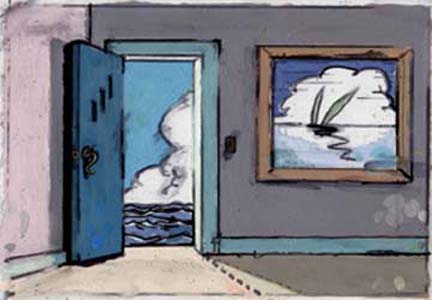
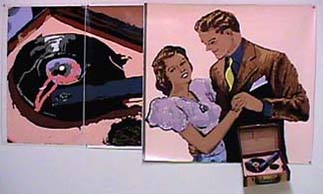
John Clem CLARKE: On weekends, I spend a lot of time roaming around antiques markets and flea markets. My paintings use the old objects and photographs I find there as a point of departure.
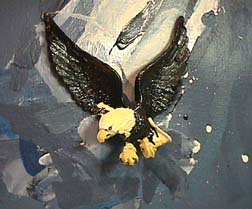
John Clem CLARKE: I frequently use illustration devices--like those used in the great ads from the fifties--to help my paintings communicate. I try to make the paintings seem as commercially produced as possible. People grew up looking at commercial illustration and print advertising, so they are comfortable with it as a visual style. I make art in a way that people find it immediately accessible.
John Clem CLARKE: I make paintings from groups of photos. It's hard combining them in a way that the light and scale appear consistent but I've learned to use a digital camera and computer for this.
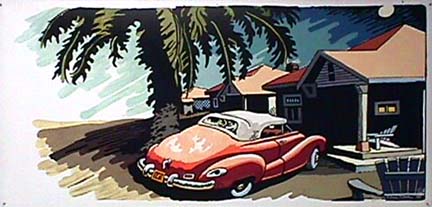
John Clem CLARKE: Before I discovered technology, I used a very different technique: I would make a maquette--a study--for the painting working in layers: the first layer was the black-line painting on mylar. Then I painted a colored layer underneath using the line drawing as an overlay. This is the same technique Disney cartoonists used years ago. Of course, when I was developing it as my own way of working, I didn't know that.
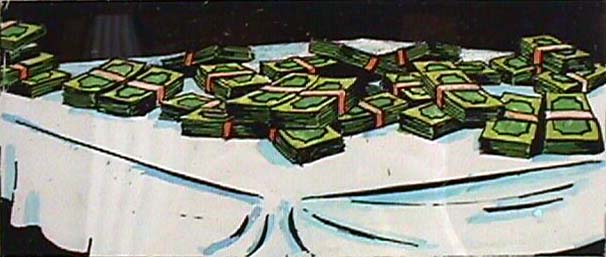
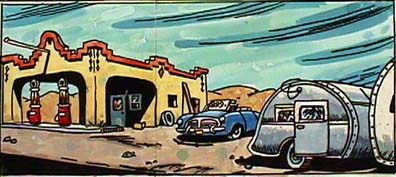
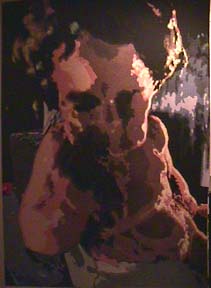

John Clem CLARKE: Until 1990, I painted on canvas on traditional stretchers. But now I paint on linen mounted on mylar. The paintings are absolutely flat and roll up; they have eyelets and are pinned directly onto the wall. This lets the image blend into the wall--so you don't know where the painting ends and the wall begins.
John Clem CLARKE: Another of series of paintings I'm doing involves pentimenti.
Editor's Note: A "pentimento" is a bit of underpainting on an artwork that was painted out in the final version. Over time, these very faint, ghostly images surface on the painting as evidence of compositional changes.
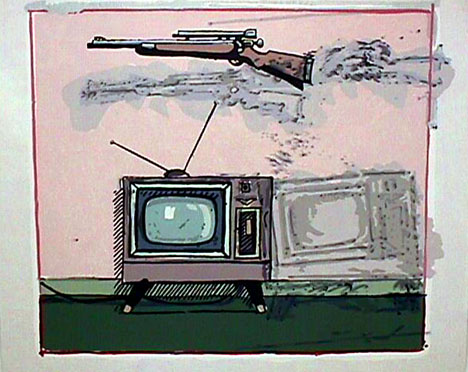
John Clem CLARKE: Instead of painting out my "mistakes", I let them stay on the canvas as alternative solutions to the painting and to show the thought process in making a painting. It bothers me when things look too good. I like to paint and paint and paint, until I get it wrong.
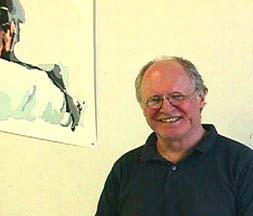
John Clem CLARKE: Art about art is a continuous thread through my work.
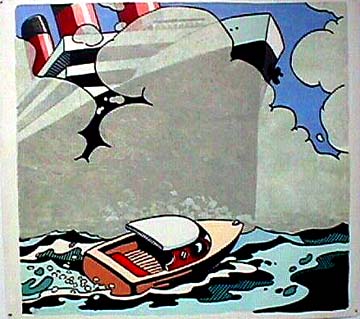
Price Range: $350-$35,000
Public Collectors of John Clem Clarke's Paintings (abbreviated list):
John Clem Clarke Solo Exhibitions (abbreviated list):
John Clem Clarke Publications (abbreviated list):
John Clem Clarke Catalogues (abbreviated list):
The Metropolitan Museum of Art (New York)
The Museum of Modern Art (New York)
The Brooklyn Museum
Whitney Museum of American Art (New York)
Museum of Contemporary Art (Chicago)
Los Angeles County Museum
Dallas Museum of Art
Hirshhorn Museum (Washington, DC)
The Fogg Art Museum, Harvard University (Cambridge, MA)
Allentown Art Museum (Allentown, PA)
Utrecht Museum (The Netherlands)
Chase Manhattan Bank (New York)
Chelsea Piers--3 murals for facade (New York)
Kornblee Gallery(New York)
OK Harris (New York)
Deson Gallery (Chicago)
Louis K. Meisel Gallery (New York)
Betts Gallery (Santa Fe)
Wassermann Galerie (Munich)
Allentown Art Museum (Allentown, PA)
02/1990 Smith, Roberts. "John Clem Clarke--Review, The New York Times
11/1990 "John Clem Clarke" (review) Art In America
1995 Capek, Michael. Artistic Trickery, Minneapolis: Lerner Publications.
1995 Higgin, Colin. Harold et Maude, Paris: Editions Denoel, cover illustration--"Ford Splash"
1972 "Whitney Review 1971-72"
1989 "Image World--Art and Media Culture," Whitney Museum of American Art, New York, p. 51
1990 Binai, Paul. "The 80's: A Post Pop Generation," Southern Alleghenies Museum of Art, Cover Illustration
1991 "Art after Art", Nassau County Museum of Art, Roslyn Harbor,
New York pp.18-21
1998 "John Clem Clarke--Comforts, Near Disasters and Pentimenti", Allentown Art Museum, Allentown, PA.
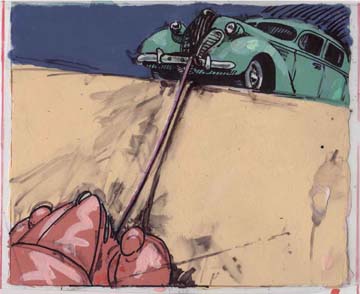
BIDDINGTON'S CREATIVE PROCESS Archives:
Sigmund Abeles Expressive Realist Painter
Nancy Azara Sculptor
Tova Beck-Friedman Sculptor & Mixed-Media Artist
Todd Bellanca Abstract Painter
Carol Bruns Bronze Figurative Sculptor
James Burnett Non-Objective Painter
Cynthia Capriata Peruvian Painter & Printmaker
Catalina Chervin Argentine Surrealist Artist
Diane Churchill Expressionist Painter
John Clem Clarke Pop Artist
Lisa Dinhofer Illusionist Painter
Tom Duncan Narrative Polychrome Sculpture
Michael Eastman Faux-Primitive Painter
Lynne Frehm New York Abstract Painter
Betsey Garand Minimalist Painter & Fine Art Printmaker
Mary Teresa Giancoli Personal Documentary Photographer
Debora Gilbert-Ryan New Image Painter
Janet Goldner African-Influenced Steel Sculpture
Harry Gordon Monumental Sculpture
Marilyn Greenberg Narrative Abstract Painter
Patricia Hansen Portrait and Still Life Painter
Richard Heinrich Welded Steel Sculpture
Charles Hewitt Painter & Monotype Printmaker
Diane Holland Intermedia Collage Artist
GH Hovagimyan Pop/Conceptual Artist
LA Hughes Pop Artist
Frances Jetter Bronze Sculptor & Editorial Illustrator
Scott Kahn Fantasy Painter
Susan Kaprov Digital Printmaker and Abstract Painter
Babette Katz Narrative Printmaker and Book Artist
Richard Mock Abstract Painter & Linocut Printmaker
Maureen Mullarkey Figure Paintings
Bill Murphy Contemporary Realist Painter
Jim Napierala Abstract Painter
Frances Pellegrini New York City & Fashion Photographer
Joseph Reeder Cross Media Artist Paintings & Ceramics
Laura Shechter Contemporary Realist Painter
Annemarie Slipper Figurative Bronzes & Ceramic Sculpture
Gary Slipper Fantasy Painter
Margaret Speer Landscape & Travel Paintings
Serena Tallarigo Marble Sculptor
Rein Triefeldt Kinetic Sculpture
Vivian Tsao Painter of Light
Nancy Van Deren Contemporary Painter
Joan Berg Victor Drawings from Nature
Edward Walsh Figurative Sculpture
Kate Wattson Contemporary Colorist Painter
Betty Winkler Organic Minimalist Painter & Printmaker
